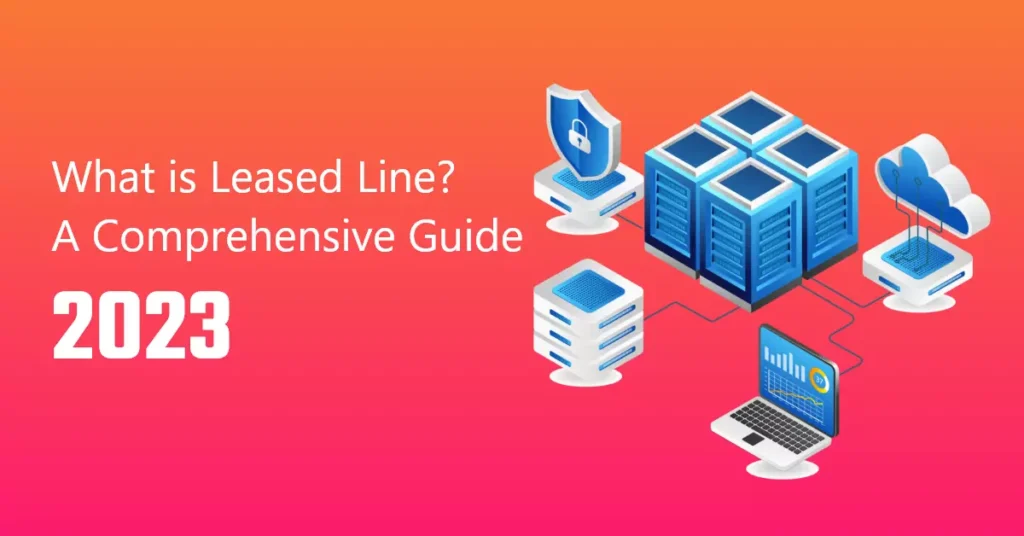What is Leased Line? A Comprehensive Guide

A leased line is a private internet connection between two or more locations and is also known as a data line or private circuit in the UK.
Today, most companies and organizations rely on online apps and networks for teamwork and communication. You need to cultivate exceptional business partnerships to thrive both now and down the road.
Purchasing internet apps is essential for dependable communications as they promote cooperation and communication. Business associations might not be as effective without the Internet. 75% of businesses attribute their income loss to an unreliable internet connection, per WiredScore research.
In this guide, we have gathered everything you need to know about leased lines so you can choose whether a leased line is the right option for your business.
Leased line : What is it?
A bidirectional phone line rented for personal usage, data exchange, or other purposes is known as a leased line. Businesses usually buy leased lines from telephone message carriers to link several geographic areas. A leased line may be referred to as a dedicated line in certain situations.
For smaller businesses, leased lines may be a costly alternative. Asymmetric digital subscriber lines, broadband, virtual private networks, and public switched telephone networks with secure messaging protocols are some alternatives to leased lines. Broadband and leased lines offer internet and phone access for a set price.
On the other hand, a leased line establishes a specific link between the company’s location and the local exchange. Broadband further has unequal data rates and flexible bandwidth.
Leased line providers offer a wide range of connection speeds, from 100Mbps to 10 Gbps. You can easily choose a speed according to your business needs.
How Leased Line Work?
The technology behind fiber optic broadband is precisely the same as that of a leased line. Light pulses are sent down a fiber optic cable to operate a leased line. The equipment at either end of a fiber optic cable monitors light, or more specifically, whether the light is on or off, representing the binary 0s and 1s of digital data when data has to be transferred down the cable. Equipment will turn lights on and off at one end to indicate 1 and 0, which is recognized, recorded, and stored as 1 and 0 by the equipment at the other end.
The speed of light is applied to this data. Since there is no way for this to happen much quicker, the only thing that can slow it down is usually how rapidly the equipment on each end can send or recognize light.
A leased line differs since it is leased to a business, not shared with hundreds of other companies. As a result, the connection to the ISP is exclusive to that specific company.
Leased Line Options for Businesses
Leasing lines often fit into one of the following groups. Take note of the perplexing synonyms in every area!
- Total Fiber, often referred to as “Ethernet Access Direct” and “Fibre Ethernet,”
The “big daddy” of internet connections is a direct, high-speed ethernet connection that travels 100% fiber optic cables from the company’s location to the internet service provider (ISP), with a maximum speed of around 1Gbps (as of this writing, 10Gbps is being tested). The most costly, of course, but also the fastest and most dependable.
- “Ethernet Broadband” or Ethernet in the First Mile (EFM)
This connection first provides a link to a business via the conventional copper network, and from the exchange, it then provides a complete fiber ethernet connection. It is, therefore, perfect for companies without a local fiber cabinet. To guarantee a robust service, it employs aggregated copper pairs, wherein the remaining copper pairs take over in the event of a failure. This implies that although the service is symmetrical and has resiliency assurances and SLAs, the speeds are much lower than those of fiber. A somewhat priced yet less expensive choice.
- “Ethernet over FTTC” (EoFTTC)
It is a more affordable alternative to EFM for companies with access to local fiber-based cabinets. It employs a combination of copper and fiber, with any speed decrease resulting from a business’s distance from the local cabinet (because copper pairs are used for the final segment of the connection from the cabinet). This is a symmetric connection that many providers offer, but it may also “burst” or increase the download speed far faster than the upload.
Uses of Leased Lines
Here are some uses of leased line :
i. Giving Access to the Internet
A dependable internet connection is essential for every successful organization in the digital era. Dedicated bandwidth provided by leased lines guarantees a reliable and fast internet connection.
Businesses with strict data needs would significantly benefit from this, as it ensures continuous access to internet resources.
ii. Connecting PCs and Servers
Leased lines connect computers and servers in different places to form a safe and effective network.
This connectedness makes it easier for employees to communicate within a company, encouraging teamwork and raising output levels.
iii. Making Phone Calls
Phone calls are clear and continuous when VoIP (voice over internet protocol) is integrated with leased lines.
This technology offers enterprises that depend on telephony affordable options in addition to enhancing voice communication.
iv. Turning on Remote Access
Leasing lines are essential for providing employees with safe remote access as the trend toward remote work surges.
These lines are an excellent option for enterprises prioritizing data protection because of their specialized nature, improving security.
v. Data Transport and Internet Traffic
Due to its high-speed data transmission architecture, leased lines are essential for transporting massive data and internet traffic throughout a network.
This capacity enhances the entire effectiveness and performance of the company’s digital infrastructure.
vi. Multimedia Streaming
The increasing use of multimedia material in company operations has led to the need for leased lines to meet the bandwidth needs of multimedia streaming.
This is especially important for companies that host webinars, video conferences, and other media-heavy events.
Types Of Leased Lines
Here are some important types of leased lines :
1- Fibre Leased Lines
Light from fibre-leased lines is sent to fiber optic cables to create a symmetric data connection. While most leased lines utilize fibre cables for most of the routing, very few use fiber cables for the whole routing. When compared to other types, fibre-leased lines provide exceptional speed.
2- Leased DSL Lines
Leased lines with limited capacity are offered via Digital Subscriber Lines (DSL). DSL connections are asymmetric and contested as opposed to leased lines, which are symmetric and non-contended. An asymmetric alternative to DSL that offers a higher upload speed is SDSL.
3- MPLS Leased Lines
MPSL, or multi-protocol label switching, is a technology that encodes and transfers data from X to Y. Labels may be applied, and based on those labels, transfers can be chosen.
Characteristics of Leased Lines
Here are characteristics of leased lines :
i- Symmetrical in Nature
The symmetrical speed architecture of leased lines guarantees equal upload and download speeds.
Leased lines offer a balanced experience; unlike regular broadband connections that frequently have asymmetrical speeds, download speeds are quicker than upload rates.
Tasks requiring substantial bidirectional data flow benefit significantly from this symmetry.
ii- Uncontended Connections
The uncontested nature of leased lines is one of its distinguishing features. This suggests that the subscriber is the only person to whom the connection is devoted.
An uncontended leased line ensures constant speeds instead of shared broadband lines, where several customers fight for capacity.
iii- One-to-One Connectivity
Leased lines function as a point-to-point connection between the Internet service provider (ISP) and the place of business.
Thanks to this direct link, the subscriber and the ISP have a dedicated, private channel for data transfer.
Advantages of Leased Line
Here are some advantages of leased line :
i- Customized Speeds
Even while 10Gbps sounds fast, not every company looking to establish leased lines will require this speed; depending on its particular needs, it may be too fast.
Leased line providers can accommodate different business needs because their lines are installed bespoke and are private, unlike traditional home or business broadband providers who offer service on a “maximum speed” basis—where the provider specifies the maximum speeds a user can expect before a contract is taken out.
To just a few, typical speeds that companies take on leased lines include 50Mbps, 100Mbps, 500Mbps, and 1Gbps.
In this manner, companies may pay the correct amount rather than a fixed cost and accept acceptable speeds based on utilization.
ii- Assistance From Your Leased Line Supplier
Many leased line providers provide their clients with far better assistance than other broadband providers, which makes sense considering the product’s significantly higher cost than alternatives and major organizations’ significant dependence on the technology.
This may involve active monitoring, in which your leased line provider will quickly address any difficulties, such as sudden slowdowns, outages, or other apparent problems.
This is in contrast to traditional consumer broadband, where customers frequently have to contact their provider to report problems before receiving any resolution.
iii- Excellent Speed
The notable guaranteed speeds companies can achieve are a significant selling point for companies considering these lines.
Leased lines may achieve astonishing rates of about 10Gbps, whereas most consumer download speeds in the UK fall between 30 and 80 Mbps.
These speeds are perfect for companies that often transmit significant volumes of data, such as video files, or mainly depend on internet-based technologies, such as cloud phone systems.
iv- No Competition with Other Users during Busiest Hours
When network traffic is excessive, businesses using consumer broadband connections experience the same difficulties as the typical home internet connection. This is because several customers on the same local lines consume all available bandwidth, which causes slower speeds and unreliable service.
Companies that operate on their private network, free from competition from other internet users, don’t have this issue while using dedicated leased lines. This implies that enterprises may take advantage of fast speeds at any time of day, even during periods of high demand.
v- Equal Download and Upload Speeds
Companies that frequently move large amounts of data would suffer if their upload speeds weren’t as dependable as their download speeds, leaving numerous files hanging and possibly stopping crucial work and advancement.
In addition to offering breakneck download speeds, leased lines offer breakneck upload speeds. These speeds, also called symmetric, are excellent for companies that frequently transfer large files because they reduce file transfer times and help businesses stay productive.
Disadvantages of Leased Line
Here are some disadvantages of leased line :
1- Pricing for Leased Lines
Compared to other commercial broadband options, leased lines are significantly more expensive, costing between £200 and £300 a month. This is in contrast to typical commercial broadband, which, depending on the service quality, might cost much less than £100 per month.
Numerous variables, including geography, required speeds, and the particular technological needs of the company, affect the cost of leased lines. Depending on the service you select, your business may have to pay more than £500 a month for speeds of 1 Gbps or faster.
Although it may seem expensive, it’s a wise investment if your company requires consistently high connections and bandwidth.
2- Time of Installation
A custom connection between your company and the nearest fiber box must be installed, so leasing lines might take much longer to build than other corporate broadband options. The installation procedure might take months if more steps like excavating or road closures are needed to place the wires, further complicating things.
Additionally, a corporation may have to spend more to enable the installation if the procedure takes longer than expected.
However, with one of the most dependable internet connections available, companies may resume work when all this unpleasantness has passed.
Final Words - Leased Line
Leased lines are among the most often considered options for a high-speed Internet connection. An allotted circuit between two communication sites is known as a leased line. Corporate offices, enterprises, internet cafés, and so forth use the leased lines.
In general, leased lines are utilized wherever continuous Internet access is needed for teamwork and communication. You may decide whether or not to get a leased line connection now that you know all the advantages and disadvantages of doing so.
If internet connectivity is not essential to your business, you can opt for broadband service and save money. You should use a leased line connection to boost efficiency and production if your company’s operations rely on the Internet.
FAQS - Leased Line
A dedicated fixed-bandwidth data connection is called a leased line. The connection that an Internet service provider directly rents to a business is called “leased.” A leased line must be point-to-point, symmetrical, and uncontested.
For enterprises, leased lines provide a lot of benefits. High symmetric speeds provide better connectivity and quicker uploads and downloads. This is the crucial benefit. Leased lines are also highly versatile and dependable. ViWhen you set up a leased line, substantial customer assistance and setup are included. For instance, if you select our EoFTTC package, our knowledgeable staff will assist you around the clock.
10Mbps connections are the starting point for leased lines, which can be scaled up to 10Gbps. After discussing your needs with our staff, they will quote you.
A dedicated, uncontested link between your location and the local exchange is known as a leased line. It is exclusive to your company. Shared and not a dedicated connection, several users use broadband.
If your situation demands it, you may increase speed once your leased line is established. You can accelerate as long as you have room on the bearer line. Our team will arrange to boost the bandwidth if you want them to.
When you select a leased provider, you have to complete an order form. Once you accept the leased line quote, a number of activities run in the background to provide you with a leased line connection.
First, select a proper place at your premises where you want the dedicated internet line circuit to terminate. Most businesses have a separate room or communication rack for this purpose. As a part of the installation process, an engineer visits your site to find out the best route for fibre optic cable from the exchange to your business premises. During this plan, they also find out how much work they have to do to get the last bit of cable into your building and the selected termination point. If your mind changes during the process and you want to change your termination point, it can cause delays in installation and increase the cost.
If you have your business set up in a rental property, you have to contact your landlord as soon as possible. It is because the permission of the landlord is required to install the circuit. If your landlord needs legal paperwork, it can also slow down the process.
A specific amount is charged from you as an installation cost. However, if your provider charges you any price above installation cost, it is known as excess construction charge. In the initial cost, providers may not be able to explain how much excess cost will be charged, but an indication is given whether they will charge this fee or not. You have 30 days to accept the quote and proceed further or to reject it without any penalty.
Time of internet leased line installation can vary depending on several factors, for example, which type of local infrastructure you already have in place. Usually, the site survey gives an estimated time of installation, but there is never a guaranteed date provided. It is because a number of parties are involved in the process of delivering the circuit. For example, if there is a need to dig up the road and install a new duct, applications are made to the local council to get permission. That is why some leased line orders can take several months to complete.
If you already have fibre optic infrastructure installed in your building, it will take a few weeks to complete the leased line installation. However, if there is no such infrastructure, you may have to wait for 45 to 90 days to complete the process. The installation of EFM takes the shortest time because there is no need for new fibre cables.
One way through which you can reduce installation time is to work with your provider by providing all the information whenever they send a query. If you have any issue with lead time, you can ask your provider to offer a temporary connectivity solution until your main service goes live.
The cost of a leased line connection varies with a number of factors, but commonly the lowest amount a business can expect to pay for a leased line is around £250 per month. This amount can vary depending on your premises location, the speed you need, monitoring and backup options.
However, if you rely entirely on the internet, five hours will seem like a long time when your whole business goes offline. That is why it is essential for you to make sure that your provider must have a backup plan. Most providers have a backup circuit that helps you keep online even if it has a slow speed. First, ask for a backup broadband connection included in the plan or not. But if you need a connection that is business-critical, you must ask your provider to provide a second leased line connection via a different route into the building. Other than that, you can have a backup supplier to keep your downtime less.
Read More: Leased Line Costs, Quotes & Prices in 2022
Read More: Leased Line Advantages And Disadvantages



